Every year at the National Association of Broadcasters' convention in Las Vegas, there is always a buzz word that dominates the three huge halls. This year it was "interoperability." What that means is that for broadcasters and print, content must be available to "everyone, all the time, and in whatever format the viewer/listener wants it."
In other words, the next Holy Grail that all these people want to move to is mobile broadband delivery. For the past five years, publishers and networks have been slowly dipping their toes into the World Wide Web as a means of brand extension for their programming. But there was reluctance to spend big bucks on what was regarded as "over the horizon" delivery.
All this changed irrevocably in November of last year when ABC decided to start putting their two hottest shows, "Desperate Housewives" and "Lost" on the Web, to be downloaded for 99 cents the day after broadcast. Immediately, thousands of fans did exactly that, and right afterwards moved the downloaded files to their iPods where they could be watched whenever they wished.
Suddenly TV news had gone from an "appointment" medium, where your local news would be broadcast at 6 p.m. every day, to an around-the-clock, worldwide content provider. The New York Times, following the mandate of publisher Arthur Sulzberger, created "Times Select," a subscription area of their Web site that contained their top columnists. In a dramatic redesign of the site last month, streaming video was made a permanent part of the home page. Just last week, the Times terminated a contract with Discovery for provision of video stories, preferring to turn this over to their own people. Six weeks ago, a photographer and photo editor from the Times turned up at the Spring Platypus workshop.
To supply this exploding new area, camera manufacturers have continued the march away from cumbersome Electronic News Gathering (ENG) cameras to smaller, High-Definition cameras, which are perfectly suited to these new mediums.
Meanwhile feature film production is undergoing its own sea change. Shooting in digital is now becoming the rule rather than the exception. Thousands of would-be George Lucases now have the technology to bypass most of the expense of production. Last month, we described how Canon decided to use its XL platform for their first HD camera. The NAB show was packed with third-party adaptors who are now providing add-ons for existing cameras that will configure them for feature film production at a relatively low cost.
So let's take a look at some of the new products that were on display:
CANON
 |
Canon's XL-H1 with Zacuto Dirck Halstead |
Because they introduced the XL-H1 HD camcorder at the end of last year [see "Camera Corner" review in our April 2006 issue], Canon featured that camera, along with some interesting new additions. They showed a model of the new 6x wide-angle lens, which will be available later this spring. However, the camera was shown a lot in third-party booths, including Zacuto, whose studio package includes, in a cine configuration, a base plate with two front rods to hold prime lenses, a repeatable focus ring, which when mounted gives the lens a hard stop at three feet, and another hard stop at infinity, making repeatable focus possible. You can also get their mount plates, which can hold monitors or hard drives.
JVC
The JVC GY- HD100U, which was introduced at last year's show, has been a terrific success for the manufacturer. They claim to have sold more than 12,000 of these cameras worldwide. In fact, each episode of "24" is shot on these cameras. The camera has a MPEG-2 codec that compresses the full HD resolution without downsizing the image. It shoots in 24fps at 720pm and comes with a 16X Fujinon pro lens and can be bought for as little as $4,9955.
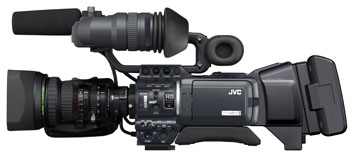 |
JVC's GY-HD250U |
This year, JVC showed the successors to this camera, the GY-HD200U and GY-HD250U. Similar in design to the 100, the new cameras feature 3 1/3 CCDs and now can shoot in 24p, 30p,and 60p. The 200 lists for $7,995, and comes with a new 17x Fujinon lens. The 250 is really intended for studio use, and adds 60i and is intended to support prime 16mm lenses or broadcast zooms. The list price is $8,995 minus glass.
PANASONIC
 |
Panasonic's AG-HVX200 Dirck Halstead |
Panasonic, like Canon, stayed with their popular AG-HVX-200 [see "Camera Corner" review in our March 2006 issue]. However, also like Canon they showed the camera with their prime lens package, which allows the user to mount prime 16mm lenses. The camera uses their P2 memory cards, and the company is increasing the size of those cards, and continuing to bring their prices down.
SONY
 |
Sony's HVR-A1U Dirck Halstead |
Sony introduced the little brother/sister to their very popular Z1U HD camera, the HVR-A1U. This camera is half the size of the Z1U, and rather than being a 3-chip camera, uses a CMOS chip with 3 megapixels. I was able to look at the image side-by-side with the Z1U image on HD monitors, and I have to tell you I couldn't see the difference. The easy access menu on the LCD, which is touch sensitive, can be used to adjust color tone and blacks. This could be an excellent low-cost addition to still photographers' camera bags, and still deliver an HD picture. Although carrying a list price of over $2,000, it is advertised on the Web for as little as $1,500.
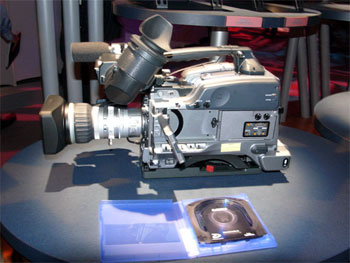 |
Sony's XDCAM F330W Dirck Halstead |
If you want to feel like a REAL pro, you should run right out to your camera store and scoop up Sony’s new XDCAM F330W. This futuristic looking ENG optical disc camera is capable of 1080i, 59i, 94i, 50i, 29.9p, 97p, 25p, and native 23.98p, making it one of the most versatile cameras on the market. It also offers a multitude of bit rate options for lower resolution recordings or offline use, and is capable of SD in XDCAM. It lists at $16,800 minus lens.
UNDER GLASS:
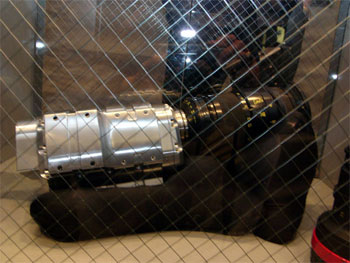 |
The Red Camera Dirck Halstead |
There were lines waiting to get into the red booth in the central hall that housed one of the most controversial items at the show.
The Red Camera looks like a piece of the Skylab. In fact it doesn't even look like a camera. It is a burnished alloy housing the size of a lunch box that has a lens attached. It was kept entirely under glass. One of the reasons it doesn't look like a camera is there is no viewfinder; that will be added later. It's what it does that is so remarkable. It is billed as the first large-format digital cinema camera. At the heart of the camera is the 12-megapixel Mysterium CMOS sensor.
To understand what is does, think of standard DV video as an 8mm film frame. HDDV could be likened to a super 16mm frame. The Red Camera shoots an image the size of a super 70mm frame.
The camera is not in production yet. When it does ship, it will cost $17,000 minus lens or viewfinder, or mic. However, at the show Red was taking deposits of $1,000. The company plans to limit production to 1,000 units. Therefore buying the camera is like speculating on real estate. I've heard of shakier deals. You can see it at http://www.red.com .
LET'S FLY AWAY
 |
Helinet's HeliProfile with Gimbal (note camera mounted under nose of helicopter) |
Two years ago in our report from NAB [see our May 2004 issue] we showed an item every video journalist should have parked in his or her carport: their own helicopter.
HELINET specializes in providing helicopters and camera systems to TV stations and film companies. At the heart of their system is the CINEFLEX camera that is usually housed in a turret under the helicopter. This gyro-stabilized camera is capable of crystal clear images of objects as small as a foot wide at an altitude of 7,500 feet from two miles away.
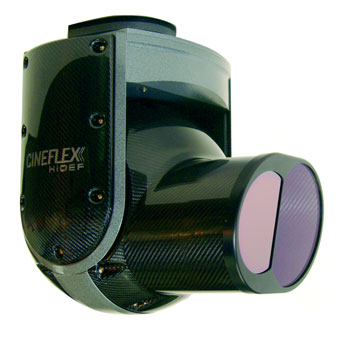 |
Gyro-stabilized "Cineflex" camera |
Helinet leases helicopters outfitted with their system, including pilots, to clients around the world. As you might imagine other than TV and film companies, some of their biggest clients are in the public sector, such as the DEA and border patrol. Helinet has been used to shoot such movies as "The Island," "Domino" and "Mission: Impossible" and has spent months shooting the most ambitious TV series ever produced, "Planet Earth," for the BBC.
So you may well ask, "Why should I care about this thing?" Well, for one thing, the camera and operator can be leased, minus the helicopter, and put on anything -- trains, planes and boats, etc. And it leases for $3,000 a day. If I were a National Geographic photographer trying to get that special shot of gazelles bounding across the African plains, I might very well consider it. The magazine has certainly spent more than that on some of the projects David Doubilet has done.
THE COOLEST GADGET OF THE SHOW
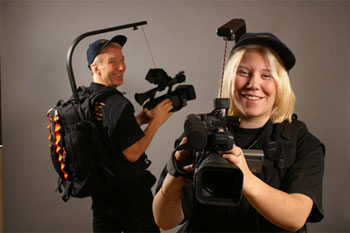 |
"Turtle X" inventor Johan Hellsten (left) and his daughter demonstrate his back-saving device. Dirck Halstead |
Johan Hellsten is a Swedish TV cameraman. Ten years ago, after spending days on his feet supporting an ENG camera while covering handball championships, he found himself wishing that his camera could be hanging from a rope, rather than crushing his shoulder. In that moment inspiration struck. “What if I could hang my camera from something rather than hold it?" he mused.
Hellsten came up with a brilliant but simple solution. He took a backpack, reinforced the back of it with steel, and inserted a five-foot curved metal bar. He then took industrial wire and hung it from the front that was curved over his head. He put a sliding stop lock on the cable that would allow him to attach his camera to the wire, and by adjustment of the lock, could make the camera virtually weightless. All of the weight load was transferred from his shoulder to the small of his back. Now he could just use his hands to guide the camera. I tried it on the show floor and was astonished. Not only was the camera light as a feather, but also I could use it like a Steadicam.
The bar is actually inserted into a back brace, which also can serve as the bottom of a backpack that can hold an XL-H1 with lens attached in sturdy compartments. After shooting you just zip on the bag, put the camera away, and carry the bag to the plane, where it tucks into the overhead bin.
There are a lot of TV shooters out there with herniated disks who probably wish Johan had gotten his idea earlier.
The Turtle X sells for $1,100.

